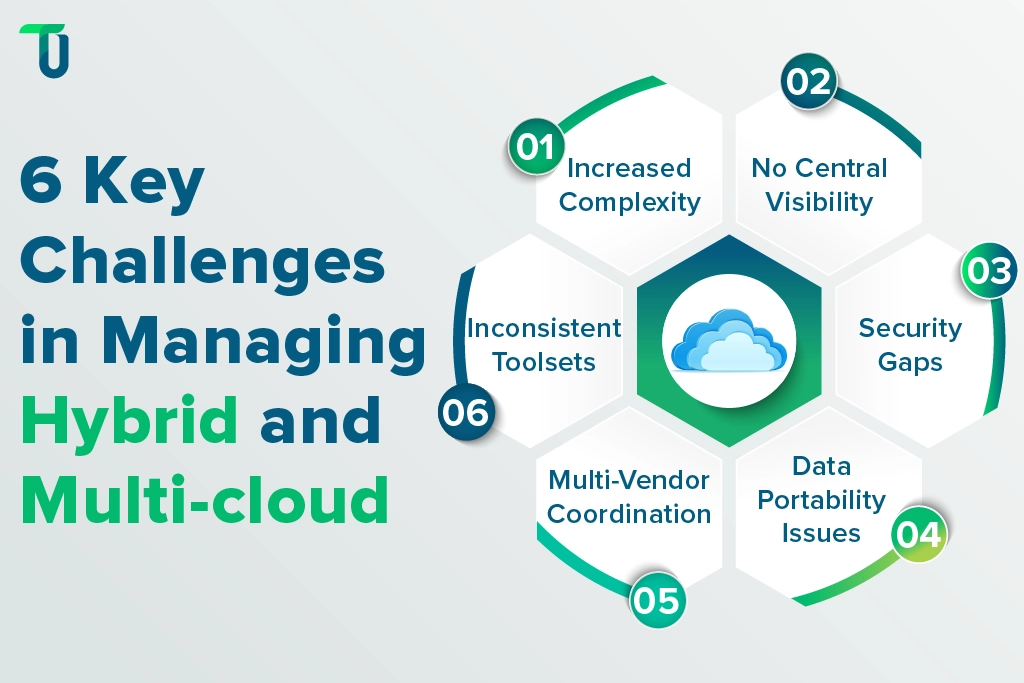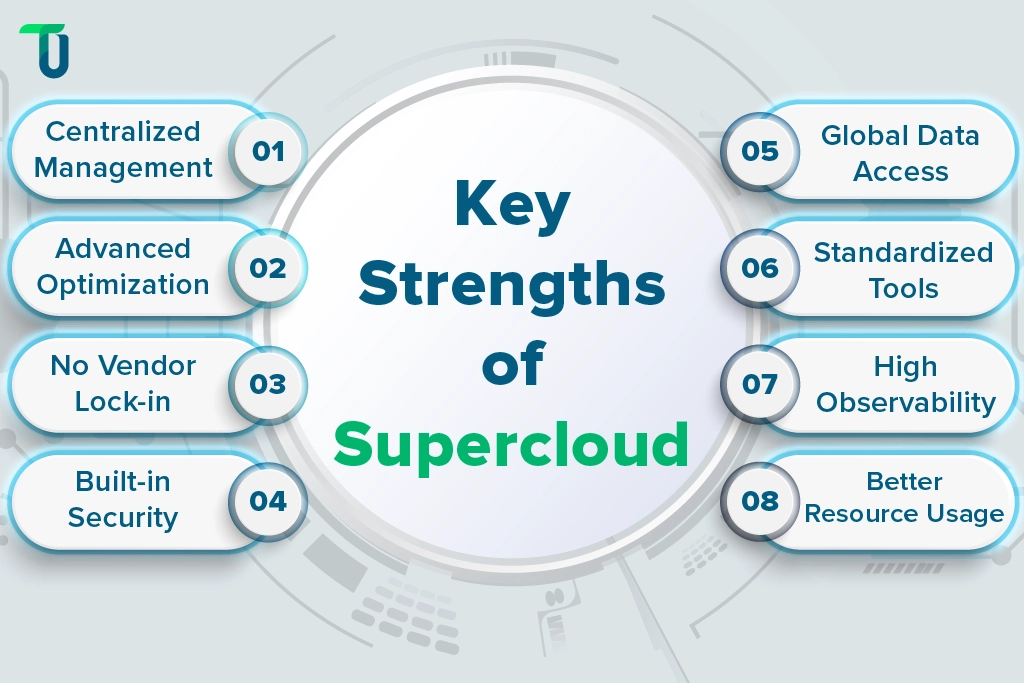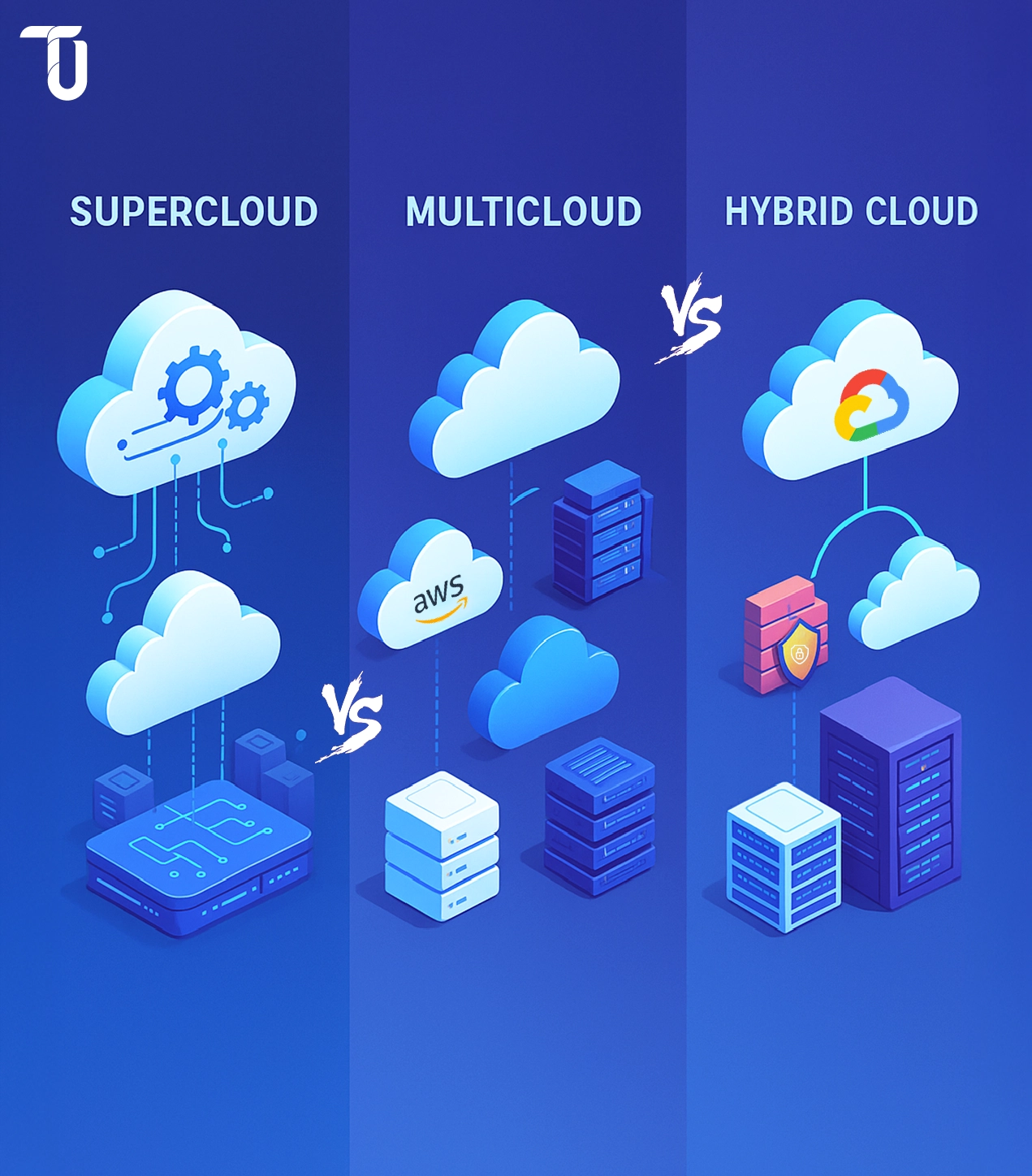Before Supercloud: Understanding Hybrid and Multi-Cloud Models
Before discussing Supercloud, let’s quickly brush up on our understanding of the two widely adopted Cloud deployment models- Hybrid Cloud and Multi-Cloud:
Hybrid Cloud: This cloud deployment model combines on-premises infrastructure and/or private cloud environments with public cloud services. This creates an integrated system that allows workloads to move between them. It’s commonly used for scenarios involving regulatory compliance, sensitive data, or legacy systems that aren’t suited for full public cloud migration.
In short, Hybrid Cloud is ideal for organizations that need both security and scalability, while keeping legacy infrastructure in use. It bridges the gap between traditional systems and modern cloud environments.
Multi-Cloud: In this approach, two or more public cloud providers (AWS, Azure, GCP) are used without necessarily integrating them into a single environment. This allows businesses to reduce dependency on any single vendor, unique services, or pricing models offered by different cloud platforms, and optimize performance.
Multi-cloud strategies are commonly adopted to avoid vendor lock-in, enhance global availability, and take advantage of best-in-class services from different providers. Unlike Hybrid Cloud, Multi-Cloud doesn’t require tight coupling between environments.
It’s worth noting that while most Multi-Cloud setups manage each Cloud separately, organizations use orchestration tools, unified management platforms, or open standards like Kubernetes to achieve tighter integrations, improve interoperability, and centralize control.
Kubernetes and service mesh technologies like Istio play a vital role in managing workloads across multi-cloud setups. These tools enhance workload portability and observability.
Did you know that organizations are embracing multi‑cloud, with usage rising from 87% to 89% year‑over‑year, according to a Flexera report?
To gain a deeper understanding of the differences between Hybrid Cloud and Multi-Cloud on key parameters, like architecture, cloud provider usage, integration level, security and compliance, deployment flexibility, and use cases, please read our dedicated blog: Hybrid Cloud vs Multi-Cloud
While both Hybrid Cloud and Multi-Cloud offer cost, compliance, and performance benefits, they also create significant cloud infrastructure management challenges.
These complexities, especially around data consistency, governance, and monitoring, are part of the reason why many enterprises are now exploring Supercloud as a way to unify control and reduce operational overhead across fragmented environments.
Why Hybrid and Multi-Cloud Are Becoming Hard to Manage
Here are six key reasons why businesses are finding it difficult to manage hybrid and multi-cloud environments:

1. Increased Complexity
Managing multiple environments, like on-premises, private, and various public clouds, requires coordination across different platforms, tools, and teams. So, you need a bigger, more skilled team for Cloud management, which ultimately increases your operational overhead.
This complexity often arises from the lack of unified orchestration frameworks or centralized cloud governance models, making daily operations and scaling difficult for enterprises.
In fact, as per the 2024 Flexera report, managing cloud spend is the number-one challenge reported by organizations for the second year running.
2. No Centralized Visibility & Control
Teams juggling multiple platforms and services, find it difficult to obtain a unified, centralized view of resources, workloads, usage, and costs across all environments. This often leads to inefficiencies in Cloud management and results in redundant resources and increased cloud spending.
Without a single pane of glass or a unified cloud operations dashboard, decision-making becomes siloed and cloud sprawl becomes inevitable.
3. Gaps in Security & Compliance
It is a challenge to maintain consistent security policies, access controls, and compliance across all environments, as each Cloud provider offers specific tools and frameworks. This results in vulnerabilities creeping into your IT infrastructure.
This lack of standardization makes regulatory compliance (like HIPAA, GDPR, or SOC 2) much harder to enforce uniformly across all workloads.
While 61% of large enterprises already use Multi‑cloud security tools and 57% use FinOps solutions, measurable results are still limited, suggests Flexera.
4. Data Integration and Portability Issues
When data moves between on-premises and Cloud or from one Cloud to another, the process becomes time-consuming, costly, and even risky, if not handled correctly. The use of different APIs, formats, and latency levels across environments could impact data integration, hinder real-time analytics, and result in poor system performance. Enterprises often struggle to ensure data consistency and synchronization across environments, which directly impacts business intelligence pipelines and real-time decision-making.
5. Vendor Management and Interoperability
As different Cloud vendors offer varied SLAs, billing models, and service interfaces, your team must manage this complexity. Further, they could face interoperability issues when trying to integrate tools or deploy workloads across platforms.
This fragmented cloud ecosystem makes it difficult to implement unified automation, increases DevOps friction, and limits application portability.
6. Operational Silos and Inconsistent Toolsets
Using the dedicated management and monitoring tools of multiple Cloud service providers often results in tool sprawl and fragmented operations. This makes scaling automation, orchestration, and DevOps practices difficult.
Tool sprawl also hinders the adoption of cloud-native best practices such as Infrastructure-as-Code (IaC), policy-as-code, and unified monitoring across all layers.
In a way, we can credit the emergence of the Supercloud to the challenges that Hybrid Cloud and Multi-Cloud setups have created. Let’s now explore what Supercloud is and how it addresses these challenges.
Curious About What Supercloud Can Do for Your Business?
Let’s connect to discuss how Supercloud can help you break free from cloud complexity, boost agility, and future-proof your infrastructure.
What Is Supercloud?
Supercloud is a relatively new cloud architecture model. It is basically a unified orchestration and management layer that sits above all your public, private, and edge environments, making them work together as a single entity. Meaning, it does not treat multiple cloud, on-premise, and edge setups as separate silos. Instead, it creates a seamless environment where data, applications, and services can move freely.
In technical terms, Supercloud acts as an abstraction layer that enables centralized governance, unified policy enforcement, and cross-platform automation for distributed cloud infrastructure.
With Supercloud, organizations can allocate, migrate, and manage as many resources (virtual machines, containers, serverless workloads) across the globe as they wish. All without the usual complexity of managing multiple clouds.
Think of Supercloud as a master control panel for your IT infrastructure. So, developers don’t need to rewrite apps for each cloud, operations teams don’t have to integrate APIs and dashboards, and businesses get consistency in security policies and performance.
It’s a misconception that Supercloud is another name for Multicloud. In reality, it is a new cloud strategy that helps bring automation, observability, and smart orchestration to Multicloud environments. Built to support modern needs, Supercloud works well for use cases like edge computing, global app delivery, and real-time data analytics.
Unlike Multicloud, which emphasizes using multiple cloud vendors, Supercloud emphasizes interoperability, platform-level intelligence, and control-plane unification across those vendors.
Core Capabilities of Supercloud: What Makes It Unique
Supercloud offers the following unique features to the Cloud management scene:

1. Centralized Management
Supercloud provides a centralized control plane that facilitates visibility and governance across all environments. So, your team doesn't have to jump between dashboards or worry about different management tools, as everything gets manageable from a single interface.
2. Smarter Workload Placement
Supercloud offers advanced scheduling and optimization capabilities. It helps analyze key factors, like cost, latency, compliance, and performance, to determine the ideal deployment environment for each application. So, your team can make faster decisions on choosing between the most cost-effective cloud provider, placing workloads closer to end users at the edge, or meeting data residency regulations in specific regions.
3. Freedom from Vendor Lock-In
By abstracting the underlying infrastructure, Supercloud eliminates cloud-specific dependencies. So, you don’t need to depend on a single cloud provider’s tools or frameworks. And you can develop and run apps across environments without significant rewrites. This leads to true portability, greater flexibility, and the freedom to use the tools you want.
4. Built-In Security and Compliance
Supercloud’s built-in security keeps things consistent across environments, from identity and access controls to encryption and policy enforcement. With all activities getting traced and logged in one place, audit capabilities increase, and compliance improves.
5. Global Access to Data
Supercloud creates a globally accessible data layer that syncs data across regions and providers while complying with data residency rules. So, you receive the level of performance required for real-time analytics or global applications.
6. Tools Developers Actually Want
Developers want to spend time building software, not managing infrastructure issues. Supercloud provides standardized APIs, SDKs, and development tools that enable developers to build once and deploy anywhere. So, they don’t have to make significant changes to apps before moving them across environments.
7. Observability and Telemetry
It’s essential to know what’s going on across all systems when your workloads span across environments. Advanced observability features, like unified logging, metrics, and tracing, help monitor performance, diagnose issues, and resolve incidents faster.
8. Better Use of Resources
No more over-provisioning or running into limits. With Supercloud, your team can dynamically scale resources across different cloud providers. Using in-built cost analytics tools, they can gain insights into usage patterns and optimize cloud spend, without sacrificing performance.
For companies looking to build a roadmap toward unified infrastructure, working with the right cloud consulting firm can simplify Supercloud implementation from day one.
Get a more detailed understanding of the history, benefits, challenges, and implementation considerations of Supercloud from our blog titled Supercloud: A paradigm shift in cloud computing.
Hybrid Cloud vs Multi-Cloud vs Supercloud: Key Differences
We’ve already discussed all three- Hybrid Cloud, Multi-Cloud, and Supercloud. Now let’s have a quick glance at how they differ across various factors.
| Feature | Hybrid Cloud | Multi-Cloud | Supercloud |
|---|---|---|---|
| Infrastructure Mix | Private + Public | Multiple Public Clouds | Public, Private, Edge—all unified |
| Management Complexity | Moderate | High (multiple providers) | Low (central control plane) |
| Orchestration | Manual or semi-automated | Siloed, per-provider tools | AI-driven, automated orchestration |
| Portability | Limited | Better, but still fragmented | App and workload agnostic |
| Security & Compliance | Easier on private side | Hard to enforce consistently | Centralized policy management |
| Use Cases | Regulated data, legacy workloads | Best-of-breed services, DR | Global apps, edge computing, real-time AI |
Why Does Supercloud Matter Now for Your Cloud Strategy
We’ve discussed how Hybrid Cloud and Multi-Cloud setups have solved many problems but also introduced new ones. Issues like tool fragmentation, siloed monitoring, inconsistent policies, and vendor sprawl make them difficult to scale efficiently. Cloud teams work around these challenges and try to bring the best out of the situation, using unified management platforms or orchestration tools. However, what concerns businesses is that managing these complex setups demands a highly skilled team and additional spending.
Supercloud offers capabilities, like global visibility, intelligent workload placement, built-in security, etc. (as we have discussed earlier) that help overcome these challenges. In fact, Supercloud has real-world applications, resolving significant use cases in industries, like finance, healthcare, Research & Development, and more. They showcase the real potential of Supercloud in transforming the Cloud management landscape. But the real question is- “Is it suitable for all?” or rather, “When to use it?”.
When To Choose Hybrid Cloud, Multi-Cloud & Supercloud
Hybrid Cloud is ideal if you have regulatory obligations or legacy apps tied to private infrastructure.
Multi-Cloud is right for teams that want flexibility, resilience, and cost optimization by spreading across providers.
Supercloud is the answer when you need everything to work together, across clouds, regions, and edges, without rebuilding apps or managing disparate tools.
Let TenUp Help You Manage Cloud Better With Supercloud
Supercloud is not here to replace Hybrid Cloud or Multi-Cloud setups. Rather, it builds on them to deliver greater efficiency and control. Think of Supercloud as the next logical step in the cloud evolution journey. It is designed to overcome the challenges of today’s globally distributed, real-time, AI-powered workloads.
So, if you have a solid Hybrid Cloud or Multi-Cloud setup, it’s a smart choice to utilize Supercloud. Reduced complexity, enhanced agility, and full control over your cloud environments- that’s what you need, right?
At TenUp, our team of highly skilled and experienced Cloud professionals can integrate Supercloud capabilities into your Cloud infrastructure. We don’t just resolve Cloud complexities, we help future-proof your Cloud strategy to support growing business demands. As an Enterprise-grade Supercloud partner , we bring proven expertise in designing, implementing, and optimizing unified cloud architectures for maximum efficiency and scalability.
Our cloud modernization services include Supercloud architecture design, API integration, cost-performance optimization, and developer enablement. We ensure your infrastructure is built for scale, security, and speed.
Hybrid and Multi-Cloud Setups Troubling You?
Our experienced team can develop Supercloud capabilities into your infrastructure and deliver your desired results.
Frequently asked questions
What problems does Supercloud specifically solve that Hybrid and Multicloud can’t?
Supercloud simplifies cloud management by unifying hybrid and multi-cloud environments. It eliminates tool sprawl, ensures consistent security, reduces vendor lock-in, and enables centralized control, something Hybrid and Multicloud models struggle to achieve.
Is Supercloud a product from a specific vendor or a general architectural approach?
Supercloud is a vendor-agnostic cloud architecture model, not a single product. It abstracts infrastructure across clouds to enable unified management and seamless operations.
How does Supercloud differ from hyperscaler solutions like AWS Outposts or Azure Arc?
Supercloud is vendor-neutral and abstracts multiple cloud environments into one layer. Unlike AWS Outposts or Azure Arc, it enables unified control across providers, avoiding lock-in and offering true workload portability.
Can existing cloud-native tools (like Kubernetes) be used to build a Supercloud?
Yes, tools like Kubernetes can serve as the foundation for Supercloud by enabling cross-cloud orchestration. When combined with service meshes and IaC tools, they support unified deployment, automation, and portability across environments.
Which industries are best suited for Supercloud adoption, and why?
Industries like finance, healthcare, retail, and scientific research benefit most from Supercloud due to their need for real-time data, regulatory compliance, and seamless operations across cloud environments.
How expensive or complex is it to implement a Supercloud compared to Multicloud?
Supercloud is more complex and costly to set up than Multicloud, but it reduces long-term overhead by unifying management, improving cost control, and simplifying cross-cloud operations.
What are the main challenges in migrating from Hybrid or Multicloud to Supercloud?
Migrating to Supercloud requires upfront effort—integrating tools, managing data migration, upskilling teams, and building abstraction layers. Yet, the long-term payoff is centralized control, automation, and true vendor independence.

